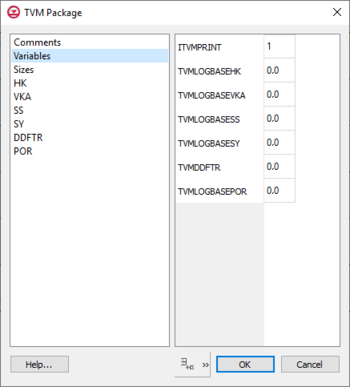GMS:TVM Package: Difference between revisions
From XMS Wiki
Jump to navigationJump to search
| Line 10: | Line 10: | ||
==Variables== | ==Variables== | ||
*ITVMPRINT | *''ITVMPRINT'' – Print flag determining how much information the TVM package will print to the listing file. | ||
** 0 = No information will be printed. | |||
** 1 = Prints what is read from the TVM input file, and how many changes occurred each time step. | |||
** 2 = Same as 1 but also includes all individual cell property value interpolation ranges and changes at each time step. | |||
*TVMLOGBASEHK | *TVMLOGBASEHK | ||
*TVMLOBASEVKA | *TVMLOBASEVKA | ||
Revision as of 22:20, 11 March 2020
| This contains information about functionality available starting at GMS version 10.5. The content may not apply to other versions. |
The Time-Variant Materials package (TVM) works with MODLOW-USG Transport. The TVM package allows hydraulic conductivity and storage values to be changed as a step function between stress periods or in a continuous manner through a transient simulation.
The TVM Package dialog is divided into two parts: one on the left which shows the main sections, and one on the right which shows the inputs for the current section.
Comments
Comment lines can be added and will appear at the top of the TVM file. Use the Add Row ![]() button to create comments. Comments can be removed using the Delete Row
button to create comments. Comments can be removed using the Delete Row ![]() button.
button.
Variables
- ITVMPRINT – Print flag determining how much information the TVM package will print to the listing file.
- 0 = No information will be printed.
- 1 = Prints what is read from the TVM input file, and how many changes occurred each time step.
- 2 = Same as 1 but also includes all individual cell property value interpolation ranges and changes at each time step.
- TVMLOGBASEHK
- TVMLOBASEVKA
- TVMLOGBASESS
- TVMLOGBASESY
- TVMDDFT
- TVMLOGBASEPOR
Sizes
- NTVMHK – The number of horizontal hydraulic conductivity (HK) values that will be changed at this stress period boundary.
- NTVMVKA – The number of vertical hydraulic conductivity (VKA) values that will be changed at this stress period boundary.
- NTVMSS – The number of Ss values that will be changed at this stress period boundary.
- NTVMSY – The number of Sy values that will be changed at this stress period boundary.
- NTVMDDFTR – The number of DDFTR values that will be changed at this stress period boundary.
- NTVMPOR – The number of porosity values that will be changed at this stress period boundary.
HK
- ITVMHK – The cell number for which horizontal hydraulic conductivity (HK) will be changed.
- HKNEW – The value of horizontal hydraulic conductivity (HK) that should be assigned to the cell at this stress period boundary.
VKA
- ITVMVKA – The cell number for which vertical hydraulic conductivity (VKA) will be changed.
- VKANEW – The value of vertical hydraulic conductivity (VKA) that should be assigned to the cell at this stress period boundary.
SS
- ITVMSS – The cell number for which Ss will be changed.
- SSNEW – The value of Ss that should be assigned to the cell at this stress period boundary.
SY
- ITVMS – The cell number for which Sy will be changed.
- SYNEW – The value of Sy that should be assigned to the cell at this stress period boundary.
DDFTR
- ITVMDDFTR – The cell number for which DDFTR will be changed.
- DDFTRNEW – The value of DDFTR that should be assigned to the cell at this stress period boundary.
POR
- ITVMPOR – The cell number for which porosity will be changed.
- PORNEW – The value of porosity that should be assigned to the cell at this stress period boundary.
Related Topics
GMS – Groundwater Modeling System | ||
|---|---|---|
| Modules: | 2D Grid • 2D Mesh • 2D Scatter Point • 3D Grid • 3D Mesh • 3D Scatter Point • Boreholes • GIS • Map • Solid • TINs • UGrids | |
| Models: | FEFLOW • FEMWATER • HydroGeoSphere • MODAEM • MODFLOW • MODPATH • mod-PATH3DU • MT3DMS • MT3D-USGS • PEST • PHT3D • RT3D • SEAM3D • SEAWAT • SEEP2D • T-PROGS • ZONEBUDGET | |
| Aquaveo | ||
